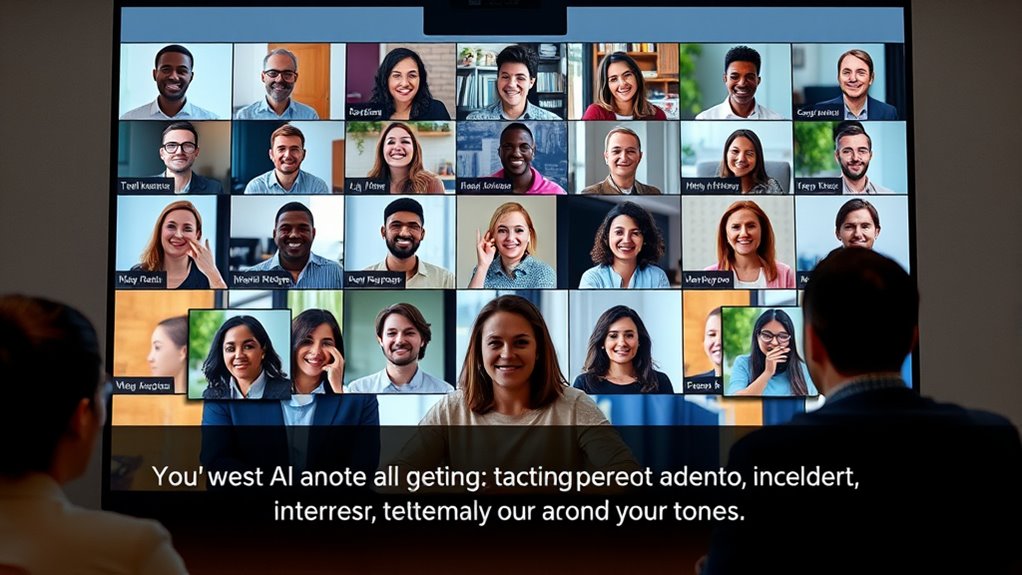AI-powered features in Zoom and Teams are making video meetings more inclusive with real-time captions and sign language highlights. These tools clarify speech, support diverse accents, and help those with hearing impairments or language barriers connect more easily. They also foster understanding through visual cues and virtual sign language interpretation. As these technologies evolve, you’ll see even more intuitive and personalized accessibility options. Stick around to explore how these innovations are transforming virtual collaboration for everyone.
Key Takeaways
- Zoom and Teams utilize AI to provide real-time captions, improving accessibility for diverse participants.
- AI-driven sign language highlights help bridge communication gaps for sign language users during meetings.
- These platforms incorporate virtual interpreters and translation features to support multilingual inclusivity.
- AI enhancements aim to reduce bias and improve caption accuracy across accents and speech patterns.
- Future developments focus on seamless, personalized accessibility tools for more inclusive virtual collaboration.
The Rise of AI-Powered Accessibility in Video Conferencing

As video conferencing becomes more integral to daily communication, AI-powered accessibility features are transforming the experience for users with hearing impairments and other disabilities. These tools provide real-time captions and sign language highlights, making meetings more inclusive. However, AI bias can sometimes affect accuracy, especially for diverse accents or speech patterns, which may lead to misunderstandings. AI bias can impact the effectiveness of these features, highlighting the need for ongoing improvements. Developers are working to reduce bias and enhance privacy protections, ensuring these AI features serve everyone fairly. Additionally, understanding the contrast ratio of AI-generated captions can help improve their clarity and readability. Careful consideration of tuning modifications can further enhance the performance of these AI systems, particularly in recognizing varied speech styles. As a result, more people with disabilities can participate fully in virtual meetings, fostering greater inclusion.
How Real-Time Captions Enhance Communication for All

Real-time captions improve communication by providing immediate textual support during meetings, ensuring everyone stays engaged and understands the discussion. They help clarify intonation and emotional expression, which can be lost in spoken words alone. When speakers emphasize certain points or use tone to convey emotion, captions reflect these nuances, making conversations more meaningful. This enhancement benefits participants with hearing impairments and those in noisy environments, but it also helps everyone better grasp the speaker’s intent. Clear captions reduce misunderstandings and keep conversations flowing smoothly. By capturing speech accurately and highlighting emotional cues, real-time captions make virtual meetings more inclusive and effective. Incorporating caption accuracy improvements ensures the captions are reliable and truly reflective of the spoken words. Additionally, advances in speech recognition technology continue to enhance the precision and usefulness of real-time captions, making communication even more seamless.
Sign Language Highlights: Bridging Language Gaps Virtually

Have you ever considered how virtual meetings can better serve participants who use sign language? With advancements in sign language recognition technology, it’s now possible to automatically generate sign language highlights during meetings. This innovation helps bridge language gaps and makes content more accessible. Additionally, virtual interpreter integration allows live sign language interpreters to participate seamlessly, ensuring clear communication for all attendees. These tools enable real-time translation and highlight key moments in sign language, making meetings more inclusive. Moreover, AI-driven safety measures monitor AI behavior to prevent miscommunications and ensure respectful interactions. By combining sign language recognition with virtual interpreter integration, platforms can provide a more equitable experience, empowering participants who rely on sign language to engage fully. This approach not only promotes inclusivity but also demonstrates a commitment to accessible communication in the digital age.
The Impact of AI on Inclusivity and User Experience

AI is transforming virtual meetings by making them more inclusive and user-friendly. It helps break down barriers through real-time captions and sign language highlights, improving overall accessibility. However, you might have privacy concerns, as AI processes sensitive data to enhance features. To adapt smoothly, you’ll need to familiarize yourself with new tools and trust the platforms’ privacy measures. The table below shows key impacts:
| Benefit | Challenge |
|---|---|
| Increased accessibility | Privacy concerns with data use |
| Seamless user experience | User adaptation to AI features |
| Real-time captions | Balancing AI accuracy and privacy |
| Sign language highlights | Learning to trust AI outputs |
Additionally, understanding how natural language processing improves communication can help users better appreciate AI’s role in creating inclusive environments.
Future Outlook: Evolving Technologies for Inclusive Virtual Meetings

As technology continues to advance, virtual meetings will become even more inclusive through innovative tools that address current limitations. Future developments will likely enhance assistive listening with better real-time audio clarity and personalized soundscapes. Visual description features will evolve, offering more detailed, automatic descriptions of shared content and surroundings. You can expect AI to provide seamless sign language interpretation and tailored captioning that adapts to your needs. These innovations will help bridge communication gaps, making virtual meetings accessible for everyone.
Future virtual meetings will be more inclusive with advanced audio, visual, and AI-driven accessibility features.
- Real-time assistive listening enhancements
- Advanced visual description for shared content
- AI-powered sign language interpretation
- Personalized captioning options
- More intuitive, user-friendly accessibility features
Frequently Asked Questions
How Accurate Are Ai-Generated Captions Across Different Accents and Dialects?
You might wonder about AI-generated captions’ accuracy across various accents and dialects. While AI has improved in handling diverse speech patterns, its effectiveness depends on accent sensitivity and dialect adaptability. Usually, it performs well with standard accents, but it can stumble with less common dialects or strong regional pronunciations. So, expect some errors, especially with diverse speech, but ongoing advancements are making captions more inclusive and accurate over time.
Can Sign Language Highlights Replace Human Interpreters During Meetings?
Imagine sign language automation replacing human interpreters overnight—sounds like a tech miracle, right? While AI highlights can boost accessibility, they can’t fully replace interpreters during meetings. Sign language automation may handle basic tasks, but it lacks the nuance, cultural understanding, and real-time adaptability of human interpreters. Relying solely on AI for interpreter replacement risks miscommunication, so human interpreters remain essential for complex, sensitive, or high-stakes conversations.
What Privacy Measures Protect User Data in Ai-Driven Accessibility Features?
You should know that privacy measures like data encryption protect your information during AI-driven accessibility features. When using these tools, your platform seeks your user consent before collecting or processing any data. This way, your conversations and sign highlights remain secure, and you maintain control over your privacy. Always review privacy policies to understand how your data is managed and guarantee your rights are safeguarded during these inclusive digital interactions.
Are AI Accessibility Tools Available for Free or Require Additional Subscriptions?
Oh, the irony is rich—some AI accessibility tools are free, so you get inclusive features without extra costs, while others demand a subscription fee. You might think, “Great, free tools should be enough,” but often, premium features come with subscription costs. So, whether you’re using free tools or paying for enhanced options, you’re investing in making meetings more inclusive—sometimes with a little extra spend, sometimes without.
How Do These AI Features Perform in Low-Bandwidth or Unstable Internet Connections?
You might wonder how AI features like captions and sign highlights perform during low-bandwidth or unstable internet connections. Network stability directly impacts feature reliability, causing delays or dropouts. In such conditions, these tools may lag or become less accurate, affecting your meeting experience. To improve performance, guarantee a stable connection or consider toggling off bandwidth-intensive features. Staying mindful of network conditions helps maintain the effectiveness of AI accessibility tools.
Conclusion
As AI transforms video meetings into a vibrant tapestry of inclusion, you’re no longer just a participant but a thread woven into a richer, more accessible fabric. These innovations act like a lighthouse, guiding everyone safely through the fog of communication barriers. With each new feature, you’re sailing toward a future where virtual meetings are truly for everyone—clear, connected, and inclusive. Embrace this wave of technology and ride it into a more equitable digital world.











